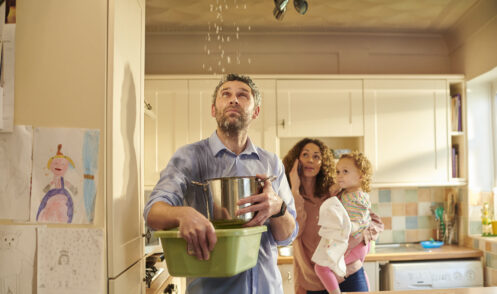Pipes are one of the things that new homeowners are often not prepared to manage. Cold pipes can freeze when the weather reaches 20 degrees Fahrenheit outside; in most climates, this temperature drop occurs at night. Since most people will be asleep at this time, frozen pipe damage is often present before morning, especially when precautions are not taken to protect the pipes.
So, what should you do when your pipes freeze and crack? We’ve compiled a list of steps to ensure you can minimize the damage caused to plumbing systems during the winter.
1. Keep an Eye on the Outside Weather and Temperature
Awareness is critical to the health of your pipes, and just being aware of how cold it is outside will go a long way toward preventing pipe freeze-ups. As it gets colder, make frequent pipe checkups to ensure you’re not experiencing any pipe freezes. It’s also a good idea to open cabinets with interior pipes so that the pipes can stay at or around room temperature.
2. Turn Off Your Water
Despite your monitoring, you may end up with a frozen pipe somewhere in your home. If this happens, the first thing you need to do is shut off the primary water supply for your house. Frozen pipes can be deceptive; when water freezes inside, you might not experience any direct repercussions until the water thaws. Therefore, turning off your water will help prevent future water damage by limiting the volume of water freezing within the pipe.
3. Find the Frozen Pipe
Pipes in basements, crawl spaces, and exterior walls are most likely to freeze in the winter months. To determine which pipes might be a problem, look for visible signs of freezing, such as condensation, excessive coldness, or frost. You can also check your faucets; faucets with little water pressure most likely have a frozen pipe somewhere in their supply lines.
4. Open All Faucets
This may seem redundant because you already turned off the water. However, water can stay in the pipes even when not in use, so this step allows excess water to drain as the pipes thaw fully. Releasing this water also helps relieve some of the pressure on the pipes, ensuring that cracks do not form during the thawing process.
5. Warm the Pipe
Now, for this part, you mustn’t be overzealous. Directly warming the pipe with an open fire or a torch is dangerous and can cause the pipe to burst. For similar reasons, pouring boiling water down the drain can cause similar issues. To warm the pipe safely, we recommend using a hair dryer set to its lowest heat output. You can also use a portable space heater to gradually warm the pipe and thaw any trapped ice within the system. In addition, you can use towels that are soaked in hot water to wrap the pipes and gradually raise their temperature.
6. Determine if There’s a Leak
This part of the process requires manual inspection of the frozen pipe. Using a flashlight to help make the pipe’s surface more visible, check to see if there are any bulging areas or cracks along the pipe’s body. Also, run your fingers along the pipe to see if there is any accumulating dampness on the body of the pipe. Next, check directly under the pipe to determine if there is any excess wetness forming, such as puddles. If you see any water leaking around the pipe, this is a clear indication that the pipe has ruptured in some way. It’s time to call a plumber for repairs.
7. Contact a Plumber
Although it is possible to thaw the pipes in your home yourself, there is always a chance that damage could have occurred. Rather than doing something wrong and having more plumbing issues to deal with, contact a professional plumber who knows what to look for when it comes to frozen pipes.
Professional contractors like Patterson Plumbing, who service areas like Greenville, TX, provide emergency services 24 hours a day. Though freezing pipes may not seem like an immediate issue if the temperature is still warm, we can also help you take preventative measures to protect your pipes so that freezing is not an issue next winter.
To learn more about what can be done to ensure your pipes are protected as well as get information on other plumbing or pipe repairs your home may need, call Patterson Plumbing today! Other plumbing services we offer include drain repair and cleaning.


